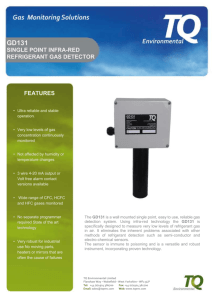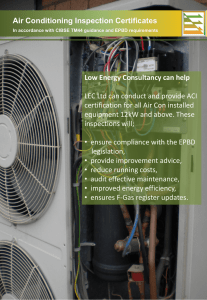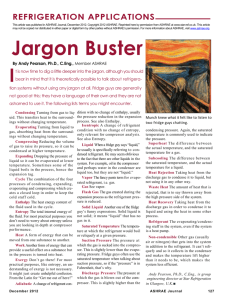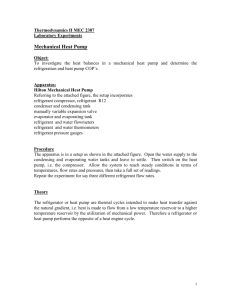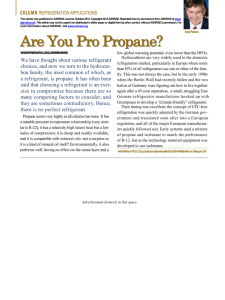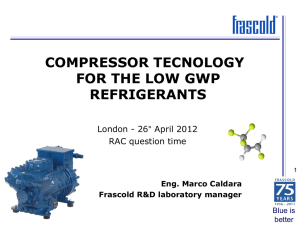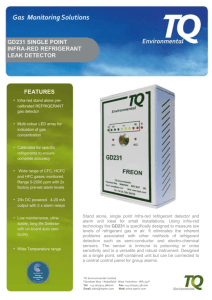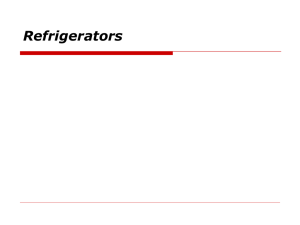Sanyo SAP air conditioning error codes
advertisement
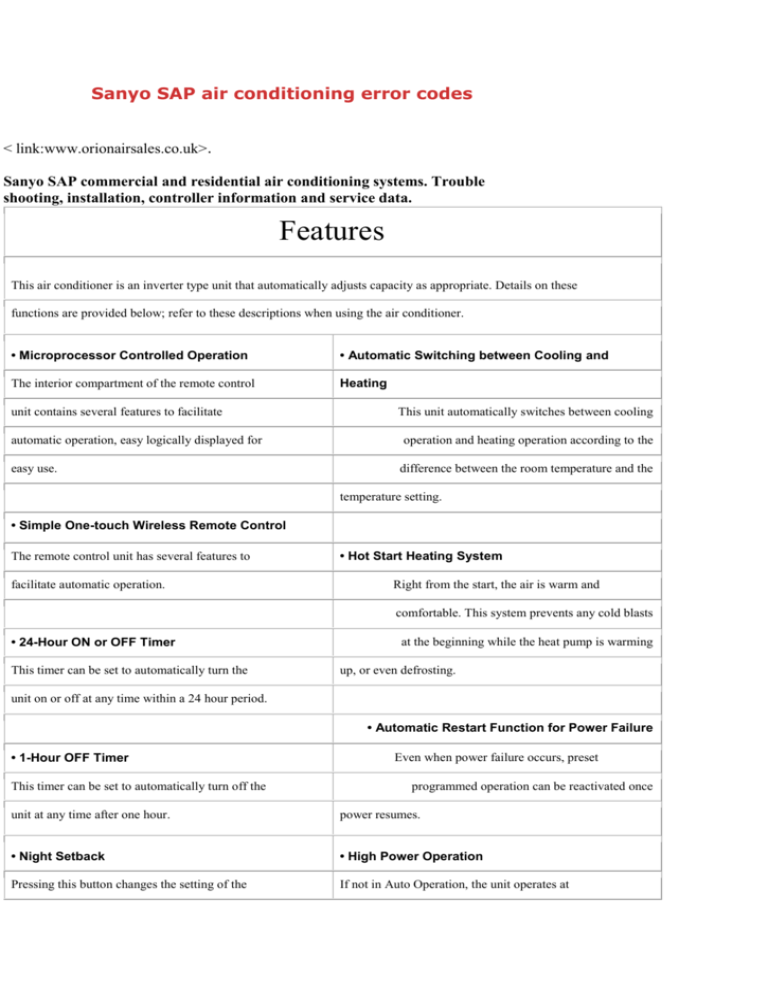
Sanyo SAP air conditioning error codes < link:www.orionairsales.co.uk>. Sanyo SAP commercial and residential air conditioning systems. Trouble shooting, installation, controller information and service data. Features This air conditioner is an inverter type unit that automatically adjusts capacity as appropriate. Details on these functions are provided below; refer to these descriptions when using the air conditioner. • Microprocessor Controlled Operation • Automatic Switching between Cooling and The interior compartment of the remote control Heating unit contains several features to facilitate This unit automatically switches between cooling automatic operation, easy logically displayed for operation and heating operation according to the easy use. difference between the room temperature and the temperature setting. • Simple One-touch Wireless Remote Control The remote control unit has several features to facilitate automatic operation. • Hot Start Heating System Right from the start, the air is warm and comfortable. This system prevents any cold blasts • 24-Hour ON or OFF Timer This timer can be set to automatically turn the at the beginning while the heat pump is warming up, or even defrosting. unit on or off at any time within a 24 hour period. • Automatic Restart Function for Power Failure • 1-Hour OFF Timer This timer can be set to automatically turn off the Even when power failure occurs, preset programmed operation can be reactivated once unit at any time after one hour. power resumes. • Night Setback • High Power Operation Pressing this button changes the setting of the If not in Auto Operation, the unit operates at room temperature thermostat, allowing you to set the temperature at whatever level that you find comfortable. • Automatic and 3-step Fan Speed Auto/High/Medium/Low maximum output for 30 minutes, regardless of the desired temperature. The fan speed is 1 step above "High". • Quiet Operation The fan rotates slower than the fan speed setting to provide a quieter operating sound. • Air Sweep Control This function moves a flap up and down in the air outlet, directing air in a sweeping motion around the room and providing comfort in every corner. • Auto. Flap Control This automatically sets the flap to the optimum position during heating, cooling, and drying operation. • Anti-Mold Filter This unit is equipped with an anti-mold filter that inhibits the growth of mold and bacteria. • Air Clean Filter An air filter that eliminates unpleasant odors and cleans the air is available. Room Temperature Control of the air conditioning system Cooling Room temperature control is obtained by cycling the compressor ON and OFF under control of the room temperature sensor in the remote control unit. l The room temperature (and other information) is transmitted every 5 minutes by the remote control unit to the controller in the indoor unit. l Once the compressor starts, it keeps running for 5 minutes. l Once the compressor stops, it will not start running again for 3 minutes. l Thermo ON : When room temperature rises 1°C above the set temperature T°C. Compressor Þ ON l Thermo. OFF : When the room temperature decreases below the set temperature T°C. Compressor Þ OFF n Heating Room temperature control is obtained by cycling the compressor ON and OFF under control of the room temperature sensor in the remote control unit. The room temperature (and other information) is transmitted every 5 minutes by the remote control unit to the controller in the indoor unit. Once the compressor starts, it keeps running for 5 minutes. Once the compressor stops, it will not start running again for 5 minutes. Thermo ON : When room temperature decreases below –1°C below the set temperature T°C. Compressor Þ ON Thermo. OFF : When the room temperature rises 1°C above the set temperature T°C. Compressor Þ OFF The temperature described in this page and previous page gives you an example with remote control operation. In case of a body sensor operation, operation temperature differ somewhat. Dry Operation (Dehumidification) of the air conditioning system Dry operation uses the ability of the cooling cycle to remove moisture from the air, but by running at low level to dehumidify without greatly reducing the room temperature. The air conditioner repeats the cycle of turning ON and OFF automatically as shown in the chart below according to the room temperature. Automatic Switching between Cooling and Heating of the air conditioning system When AUTO mode is selected, the microprocessor calculates the difference between the set temperature and the room temperature, and automatically switches to COOLING or HEATING mode to maintain the desired temperature. Room temp. Set temp. Þ COOL Room temp. < Set temp. Þ HEAT This means that if the room temperature is higher than or equal to the set temperature, COOLING operation begins. If the room temperature is lower than the set temperature, HEATING operation begins. Example of operation in the AUTO mode with the set room temperature at 23 C. The air conditioner changes the operation mode (from cool to heat or vice versa) TROUBLESHOOTING the air conditioning system Check power supply wiring Check that power supply wires are correctly connected to terminals L and N on the terminal plate in the indoor unit. 9-1-2. Check inter-unit wiring. Check that inter-unit wiring is correctly connected between indoor unit and outdoor unit. 9-1-3. Check power supply. Check that voltage is in specified range (±10% of the rating). Check that power is being supplied. 9-1-4. Check lead wires and connectors in indoor and outdoor units. Check that coating of lead wires is not damaged. Check that lead wires and connectors are firmly connected. Check that wiring is correct. 2. Air conditioner does not operate. 9-2-1. Circuit breaker trips (or fuse blows). A. When the circuit breaker is set to ON, it is tripped soon. (Resetting is not possible.) There is a possibility of ground fault. Check insulation resistance. If resistance value is 2Mor less, insulation is defective 9-2-2. Neither indoor nor outdoor unit runs. A. Power is not supplied. B. Check "LED lamps" on the front of indoor unit. (Refer to item "8-9.Self Diagnostic Function".) YES• OPERATION lamp, TIMER lamp or STANDBY lamp is blinking. • Refer to "Self diagnostic function" to find the error. Then, repair or replace the defective parts. NO • Check power supply. Power is being supplied to the indoor unit. Circuit breaker is tripped. Power failure Reset breaker. Wait for recovery or contact power company. Executing self-diagnostics After turning on power to the air conditioner, use the remote controller and follow the steps below to execute self-diagnostics. Step 1: Press and hold the remote controller QUIET button and 1 HR TIMER button. At the same time, press the ACL (reset) button. Use a pointed object such as the tip of a pen to press the ACL button. When this has been done, "oP-1" (test run) appears, blinking, in the remote controller clock display area. Step 2: Next, press the 1 HR TIMER button once to change the display from "oP-1" to "oP-3" (self-diagnostics). (The display continues to blink.) Step 3: Finally press the ON/OFF button to engage self-diagnostics mode. • The self-diagnostics function utilizes the 3 indicator lamps on the main unit, in combinations of ON lamps, blinking lamps, and OFF lamps, to report the existence of sensor trouble or a protective operation. (The lamps blink or remain ON for 5 seconds, then turn OFF for 2 seconds.) Self-diagnostics is completed when the buzzer sounds 3 short beeps. • A maximum of 3 self-diagnostics reports are displayed, for 5 seconds each, beginning with the most recent report. Following this display the lamps turn OFF. In order to view the self-diagnostics results again, press the ON/OFF button again. • The 3 lamps remain OFF if no trouble has occurred. <IMPORTANT> After self-diagnostics is completed, be sure to press the ACL (reset) button to return to normal mode. The air conditioner will not operate if this is not done. NOTE 1: If the operation lamp blinks every 0.5 seconds immediately when the power is turned ON, there is an external ROM (OTP data) failure on the indoor circuit board, or a ROM socket insertion problem, or the ROM has not been installed. 2: The failure mode is stored in memory even when the power is not ON. Follow the procedure below to perform diagnostics Code Diagnostics item Diagnostics contents S01 Room temperature sensor failure 1Sensor open circuit or short circuit S02 Indoor heat exchanger sensor failure 2Contact failure at connector or open circuit at terminal crimping location (short-circuit detection only for the humidity sensor) 3Indoor/outdoor circuit board failure S03 Humidity sensor failure S04 Compressor temperature sensor failure S05 Outdoor heat exchanger sensor failure S06 Outdoor air temperature sensor failure S07 Outdoor electrical current detection failure Outdoor circuit board failure E01 Indoor/outdoor communications failure (serial communications) 1Mis-wiring 2 AC power failure 3Blown fuse 5Indoor or outdoor circuit board failure 1Sensor open circuit or short circuit 2Contact failure at connector or open circuit at terminal crimping location 3Outdoor circuit board failure 4Power relay failure E02 • HIC circuit failure • Power Tr (transistor) circuit failure 1HIC or power Tr failure 2Outdoor fan does not turn. 3Instantaneous power outage 4Service valve not opened. 5Outdoor fan blocked. 6Continuous overload operation 7Compressor failure 8Outdoor circuit board failure E03 Outdoor unit external ROM (OTP data) failure 1External ROM data failure E04 Peak current cut-off 1Instantaneous power outage 3Outdoor circuit board failure E05 • PAM circuit failure • Active circuit failure 1Outdoor circuit board failure E06 Compressor discharge overheat prevention activated. 1Electric expansion valve failure 2Capillaries choked 3Shortage of refrigerant 4Continuous overload operation 5Outdoor fan does not rotate 6Outdoor circuit board failure E07 Indoor fan operating failure 1Fan motor failure E08 • 4-way valve switching failure • Indoor zero-cross failure 14-way valve failure (heat pump model only) 2Outdoor circuit board failure E09 No-refrigerant protection 1Service valve not opened. E10 DC compressor drive circuit failure 1Open phase E11 Outdoor fan operating failure 1Fan motor failure E12 • Outdoor system communications failure • Outdoor high-pressure SW • OLR operation • Outdoor power supply open phase • Outdoor coil freezing 1Mis-wiring 2Blown fuse 5Outdoor circuit board failure E13 Freeze-prevention operation activated. 1Indoor fan system failure 2Outdoor circuit board failure 2HIC or power transistor failure 2Outdoor power supply voltage failure 2Contact failure at connector 3Indoor circuit board failure 2Shortage of refrigerant 2Outdoor circuit board failure 2Contact failure at connector 3Power relay failure 6Compressor failure 2Shortage of refrigerant 3Outdoor circuit board failure 4Open phase 3Low-temperature operation 11. CHECKING ELECTRICAL Components 11-1. Measurement of Insulation Resistance The insulation is in good condition if the resistance exceeds 1M. 11-1-1. Power supply cord Clamp the grounding wire of power cord with the lead clip of the insulation resistance tester and measure the resistance by placing a probe on either of the two power wires. Then also measure the resistance between the grounding and other power terminals. (Fig. 1) 11-1-2. Indoor unit Clamp an aluminum plate fin or copper tube with the lead clip of the insulation resistance tester and measure the resistance by placing a probe on each terminal screw where power supply lines are connected on the terminal plate. 11-1-3. Outdoor unit Clamp an aluminum plate fin or copper tube with the lead clip of the insulation resistance tester and measure the resistance by placing a probe on each terminal screw on the terminal plate. Note that the ground line terminal should be skipped for the check. 11-1-4. Measurement of insulation resistance for electrical parts Disconnect the lead wires of the desired electric part from terminal plate, capacitor, etc. Similarly disconnect the connector. Then measure the insulation resistance. 12. REFRIGERANT R410A: SPECIAL PRECAUTIONS WHEN SERVICING UNIT 12-1. Characteristics of New Refrigerant R410A 12-1-1. What is New Refrigerant R410A? R410A is a new refrigerant that contains two types of pseudo-non-azeotropic refrigerant mixture. Its refrigeration capacity and energy efficiency are about the same level as the conventional refrigerant, R22. 12-1-2. Components (mixing proportions) HFC32 (50%) / HFC125 (50%) 12-1-3. Characteristics Less toxic, more chemically stable refrigerant The composition of refrigerant R410A changes whether it is in a gaseous phase or liquid phase. Thus, when there is a refrigerant leak the basic performance of the air conditioner may be degraded because of a change in composition of the remaining refrigerant. Therefore, do not add new refrigerant. Instead, recover the remaining refrigerant with the refrigerant recovery unit. Then, after evacuation, totally recharge the specified amount of refrigerant with the new refrigerant at its normal mixed composition state (in liquid phase). l When refrigerant R410A is used, the composition will differ depending on whether it is in gaseous or liquid phase, and the basic performance of the air conditioner will be degraded if it is charged while the refrigerant is in gaseous state. Thus, always charge the refrigerant while it is in liquid phase. 12-2. Checklist Before Servicing Use a clutch-type flare tool for R410A or the conventional flare tool. Note that sizes of the resultant flares differ between these two tools. Where a conventional flare tool is used, make sure to observe A Specification (amount of extrusion) by using the flare spacer. Tubing precautions Refrigerant R410A is more easily affected by dust or moisture compared with R22, thus be sure to temporarily cover the ends of the tubing with caps or tape prior to installation. Never use 0.7mm-thick copper tubing or tubing which is less than 0.8mm in thickness, since air conditioners with R410A are subject to higher pressure than those using R22 and R407C. No addition of compressor oil for R410A No additional charge of compressor oil is permitted. No use of refrigerant other than R410A Never use a refrigerant other than R410A. If refrigerant R410A is exposed to fire Through welding, etc., toxic gas may be released when R410A refrigerant is exposed to fire. Therefore, be sure to provide ample ventilation during installation work. Caution in case of R410A leak Check for possible leak points with the special leak detector for R410A. If a leak occurs inside the room, immediately provide thorough ventilation. 12-5-1. Procedure for replacing compressor (1) Recovering refrigerant Any remaining refrigerant inside the unit should not be released to the atmosphere, but recovered using the refrigerant recovery unit for R410A. Do not reuse the recovered refrigerant, since it will contain impurities. (2) Replacing Compressor l Soon after removing seals of both discharge and suction tubes of the new compressor, replace it quickly. (3) Checking for sealing Use nitrogen gas for the pressurized gas, and never use a refrigerant other than R410A. Also do not use oxygen or any flammable gas. (4) Evacuation Use a solenoid valve-installed vacuum pump so that even if power is cut off in the middle of evacuation of air due to a power interruption, the valve will prevent the pump oil from flowing back. The equipment may be damaged if moisture remains in the tubing, thus carry out the evacuation thoroughly. When using a vacuum pump with exhaust air volume more than 25L/min. and ultimate vacuum pressure rate of 0.05Torr: Length of tubing Time Less than 10 meters More than 10 meters More than 10 minutes More than 15 minutes (5) Recharging Be sure to charge the specified amount of refrigerant in liquid state using the service port of the wide tube service valve. The proper amount is listed on the unit's nameplate. When the entire amount cannot be charged all at once, charge gradually while operating the unit in Cooling Operation. When charging with a refrigerant cylinder, use an electronic scale for charging refrigerant. In this case, if the volume of refrigerant in the cylinder becomes less than 20% of the fully-charged amount, the composition of the refrigerant starts to change. Thus, do not use the refrigerant if the amount in the charging cylinder is less than 20%. Also, charge the minimum necessary amount to the charging cylinder before using it to charge the air conditioning unit. Example: In case of charging refrigerant to a unit requiring 0.76Kg using a capacity of a 10Kg cylinder, the minimum necessary amount for the cylinder is: 0.76 + 10 0.20 = 2.76Kg For the remaining refrigerant, refer to the instructions of the refrigerant manufacturer. l If using a charging cylinder, transfer the specified amount of liquid refrigerant from the refrigerant cylinder to the charging cylinder. Prepare an evacuated charging cylinder beforehand. Do not use the refrigerant if the amount in the charging cylinder is less than 20%. CAUTION Never charge a large amount of liquid refrigerant at once to the unit. This may cause damage to the compressor. CAUTION To prevent the composition of R410A from changing, never bleed the refrigerant gas into the atmosphere while transferring the refrigerant. 12-7. Charging Additional Refrigerant 12-7-1. When Tubes are Extended l Observe the proper amount of refrigerant as stated in this service manual or the installation manual that came with the indoor unit. Charge additional refrigerant in liquid state only. 12-8. Retro-Fitting Existing Systems 12-8-1. Use of Existing Units l Never use new refrigerant R410A for existing units which use R22.This will cause the air conditioner to operate improperly and may result in a hazardous condition. 12-8-2. Use of Existing Tubing If replacing an older unit that used refrigerant R22 with a R410A unit, do not use its existing tubing. Instead, completely new tubing must be used. CAUTION Never charge additional refrigerant if refrigerant is leaking from the unit. Follow instructions given in “12-6. In Case Refrigerant is Leaking” and completely carry out repairs. Only then should you recharge the refrigerant.

